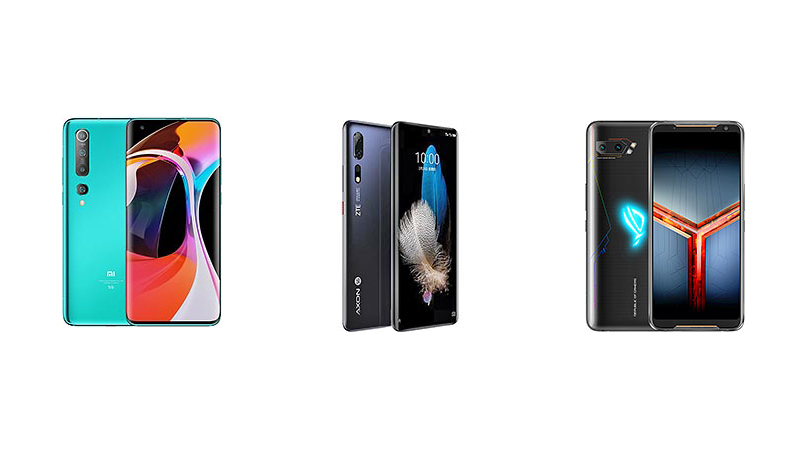If you need a flagship smartphone boasting the highest performance and Android, most of the time you have to opt for a device fueled by one of the latest Qualcomm’s high-end processors. The latest flagship SoC by the San Diego-based chipmaker is the Snapdragon 865. If we exclude the expensive Samsung Galaxy S20 lineup, the only smartphones announced with that chipset are Xiaomi Mi 10 and ZTE Axon 10s Pro 5G. Here, we decided to compare them and, for obvious reasons, we also decided to include the best gaming phone out there in the comparison: Asus ROG Phone II. If you want to find the best affordable flagship with a monster performance, go ahead with this specs comparison.
Xiaomi Mi 10 vs ZTE Axon 10s Pro vs Asus ROG Phone II
| Xiaomi Mi 10 | ZTE Axon 10s Pro | Asus ROG Phone II | |
|---|---|---|---|
| DIMENSIONS AND WEIGHT | 162.6 x 74.8 x 9 mm, 208 g | 159.2 x 73.4 x 7.9 mm, 175 g | 171 x 77.6 x 9.5 mm, 240 g |
| DISPLAY | 6.67 inches, 1080 x 2340p (Full HD+), Super AMOLED | 6.47 inches, 1080 x 2340p (Full HD+), AMOLED | 6.59 inches, 1080 x 2340p (Full HD+), AMOLED |
| PROCESSOR | Qualcomm Snapdragon 865, octa-core 2.84 GHz | Qualcomm Snapdragon 865, octa-core 2.84 GHz | Qualcomm Snapdragon 855+, octa-core 2.96 GHz |
| MEMORY | 8 GB RAM, 128 GB – 8 GB RAM, 256 GB – 12 GB RAM, 512 GB | 6 GB RAM, 128 GB – 12 GB RAM, 256 GB – micro SD slot | 8 GB RAM, 128 GB – 12 GB RAM, 256 GB – 12 GB RAM, 512 GB – 12 GB RAM, 1 TB |
| SOFTWARE | Android 10, MIUI | Android 10, Mi Favor | Android 9 Pie, ROG UI + Android stock |
| CONNECTIVITY | Wi-Fi 802.11 a/b/g/n/ac/ax, Bluetooth 5.1, GPS | Wi-Fi 802.11 a/b/g/n/ac/ax, Bluetooth 5.0, GPS | Wi-Fi 802.11 a/b/g/n/ac/ad, Bluetooth 5.0, GPS |
| CAMERA | Quad 108 + 13 + 2 + 2 MP, f/1.7 + f/2.4 + f/2.4 + f/2.4 20 MP f/2.0 front camera |
Triple 48 + 8 + 20 MP, f/1.7 + f/2.4 + f/2.2 20 MP f/2.0 front camera |
Dual 48 + 13 MP, f/1.8 + f/2.4 24 MP f/2.2 front camera |
| BATTERY | 4780 mAh, fast charging 30W, Fast wireless charging 30W | 4000 mAh, fast charging 18W and wireless charging | 6000 mAh, fast charging 30W |
| ADDITIONAL FEATURES | Dual SIM slot, reverse wireless charging 10W, 5G | Hybrid Dual SIM slot, 5G | Dual SIM slot, reverse charging, support for external accessories, RGB LEDs |
Design
Glass backs, aluminum frames, and great build quality. These are the aspects these three devices share in common. Asus ROG Phone II is a gaming phone, so you get a gaming-centric design that is all but elegant and sober. It comes with RGB LEDs and an aggressive look for gamers who can attach to it some interesting external accessories. Xiaomi Mi 10 looks the most elegant one due to its punch-hole display with a front camera embedded and a display with curved sides. On the other hand, ZTE Axon 10s Pro has the most compact and thinnest body since it packs a smaller display and a smaller battery.
Display
If you are a gamer or you like having a smooth user experience, go for the Asus ROG Phone II. I would prefer it because of its high 120 Hz refresh rate, 240 Hz touch sampling rate, a 108% DCI P3 coverage and powerful stereo speakers placed frontally. Xiaomi Mi 10 has a lower refresh rate (90 Hz) and a lower touch sampling rate (180 Hz) but it still comes with an amazing display and, unlike the ROG Phone II, it supports the HDR10+ technology for improved image quality on streaming platforms. ZTE Axon 10s Pro has an HDR display with a standard 60 Hz refresh rate, so nothing really special for a flagship.
Hardware/Software
Xiaomi Mi 10 and ZTE Axon 10s Pro are powered by a better chipset: the Snapdragon 865. It is currently the best chipset you can find on Android-powered devices. The Asus ROG Phone II is fueled by the best Qualcomm chipset of 2019: the Snapdragon 855+. But even though it has a lower-end chipset, you should not underestimate the Asus ROG Phone II. Its SoC has lower performance, but the smartphone comes with an amazing cooling system, up to 1 TB of internal storage (which you do not get on the Xiaomi Mi 10 and ZTE Axon 10s Pro) and the support to interesting external accessories such as a desktop dock. On the other hand, Asus ROG Phone II lacks 5G connectivity, unlike its rivals. And it runs Android 9 Pie out of the box, but it was updated to Android 10.
Camera
On the paper, Xiaomi Mi 10 has a much better camera department. It mounts a quad camera including a great 108 Megapixel main sensor with OIS, an ultrawide sensor, a dedicated macro camera, and a depth sensor. Unlike the ZTE Axon 10s Pro coming with 3x optical zoom, Xiaomi Mi 10 lacks a telephoto sensor and this may be a big con for several users. The weakest point of the Asus ROG Phone II is the camera department: it has just a dual camera and it does not even come with OIS.
Battery
Asus ROG Phone II is the winner of the battery comparison since it packs a mammoth 6000 mAh battery and it is one of the longest-lasting flagships on a single charge. Unfortunately, it does not support wireless charging, unlike Xiaomi Mi 10 and ZTE Axon 10s Pro. But that huge battery can also be used as a power bank through wired charging. The silver medal goes to Xiaomi Mi 10 with a 4780 mAh battery, the fastest charging speeds, wireless charging and reverse wireless charging.
Price
Xiaomi Mi 10 starts from about €530/$572 in China, while Asus ROG Phone II is available for about €500/$540 globally in its base variant (street price). ZTE Axon 10s Pro is still not on sale. Our final verdict awards the Xiaomi Mi 10: Asus ROG Phone II is definitely a very interesting and unique phone, but it lacks 5G connectivity and flagship cameras. But if you are a gamer, Asus ROG Phone II may fit your needs more due to its huge battery, amazing 120 Hz display, those Asus external accessories, and more.
- Read More: Xiaomi sold Mi 10 units worth 200 million yuan within a minute in its first sale in China
Xiaomi Mi 10 vs ZTE Axon 10s Pro vs Asus ROG Phone II: PRO and CONS
ZTE Axon 10s Pro
PROS
- Slimmer design
- Great hardware
- More compact
- Wireless charging
CONS
- Inferior display
Asus ROG Phone II
PROS
- Huge battery
- Reverse wireless charging
- Support for gaming accessories
- Reverse charging
CONS
- No 5G
Xiaomi Mi 10 5G
PROS
- Amazing cameras
- Reverse wireless charging
- Punch-hole display
- Faster charging speeds
CONS
- Nothing particular








